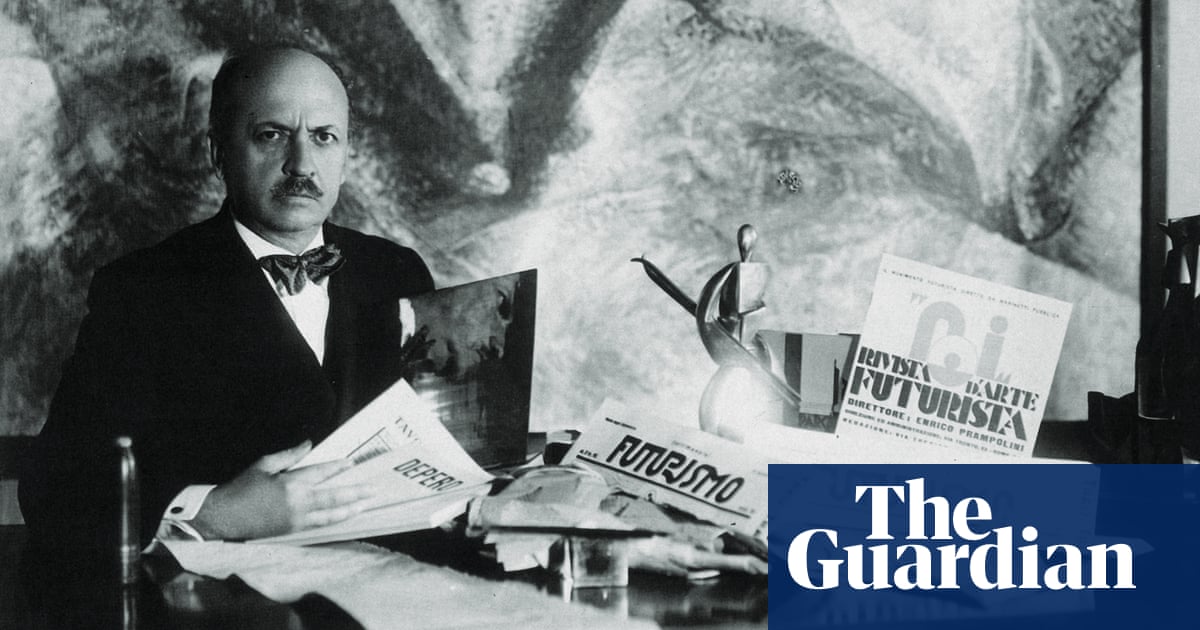Filippo Tommaso Marinetti was the Elon Musk of the early 20th century, combining a joy in technological innovation with an appetite for illiberal politics. Where Musk builds rockets, Marinetti celebrated those shiny new inventions, the aeroplane and the motor car. The Futurist Manifesto, which he wrote when the movement existed only in his head, begins with a rhapsodic account of a fast drive that ends in a crash, which delights him more than the Winged Victory of Samothrace, the famous Greek sculpture in the Louvre. Machines, he believes, make all previous art irrelevant. Futurism will hymn the hard new beauty.
Marinetti’s role in the making of the modern world is insufficiently recognised, presumably because he was so contentious and offensive to mainstream democratic values. Futurism is celebrated for the artists and architects it inspired, rather than its manifesto-issuing, speech-making, rabble-rousing leader. But an exhibition opening this month at London’s Estorick Collection draws attention to Marinetti’s own creative contribution to futurism. Entitled Breaking Lines, it centres on what Marinetti called “words in freedom”, the formless, collage-like experimental poetry he invented in his 1912-13 sound and concrete poem Zang Tumb Tuuum.
The show is a chance to reconsider this brilliant yet alarming figure at a time when his brand of politics may be making a comeback. In photographs, he looks a mixture of dictator and dandy, his moustache an emphatic black flourish with martial upturned points, as he poses like an orator or lounges at a cafe table, appearing every bit the bohemian poet he was. Born in Egypt in 1876 to Italian parents, he was educated in Paris and wrote poetry in French. It was his easy intimacy with the Parisian avant garde that enabled him to announce his own cultural revolution.
He would have loved Musk’s X and admired its owner’s attention-grabbing posts, for he was nothing if not a sharp communicator. Marinetti managed to get the Futurist Manifesto, his announcement of an obscure avant garde grouping, published in full on 20 February 1909 on the front page of Le Figaro. This publicity coup set the tone for the heavily advertised “futurist evenings” he and his followers staged across Europe – including at the London Coliseum, scandalising the Edwardian world and deliberately provoking scuffles.
But Marinetti outdid Musk politically. Where the Tesla founder supports far-right fools, Marinetti worked with the original, self-proclaimed fascist, his fellow Milan resident Benito Mussolini, dictator of Italy from 1922 to 1943. Marinetti and Mussolini were, in 1915, among the loudest voices calling for neutral Italy to enter the first world war on the “modern” Franco-British side against the sclerotic Austro-Hungarian empire. They were arrested together for their agitation, but won the argument.
The deaths of futurists in the war that Marinetti had so wanted, including the movement’s greatest artist Umberto Boccioni, did nothing to disillusion him. After one nationalist action, he and Mussolini were jailed together. Futurism became ever more political, forming its own street-fighting shock troops. In 1919, futurists were among the anti-liberal forces who joined together in Milan to found fascism. Marinetti was one of its first electoral candidates.
Futurism and fascism only fell out because Marinetti was too radical for Mussolini’s middle-class supporters. Hating the grip of the church on Italy, he made a speech attacking the papacy at the first Fascist Congress. This was not what Mussolini needed as he built a conservative hegemony. Marinetti became instead a tame artistic icon of the dictatorship, appointed to Mussolini’s Academy of Italy in 1929. He stayed loyal and died among the hardcore fascists in Mussolini’s Republic of Salò in 1944.
Fascism was not monolithic and there were differences as well as connections between Mussolini’s Italy, Hitler’s Germany and, say, Admiral Horthy’s “National Conservatives” in Hungary. But one thing all fascists in the early 20th century had in common was the celebration of violence that started with Marinetti’s Futurist Manifesto.
To understand this incredible document of the modern world, you have to imagine how things were back in 1909. Human flight was less than a decade old. The Titanic hadn’t sunk yet. As for modern art, it was still in its infancy, as Picasso and Braque worked in secrecy to perfect cubism.
Marinetti invented the artistic manifesto itself, a rhetorical form later copied by surrealism, Fluxus and others. By extension, he also created the idea of the art movement as a quasi-ideological group. Where previous “isms” were facetiously named by their critics, futurism announced itself.
War is at the heart of the new aesthetic unveiled by his manifesto. “We intend to exalt aggressive action … the punch and the slap,” it says early on, introducing, you might think, an avant garde appetite for comic violence that would be shared by dadaists and surrealists. But this is different: “No work without an aggressive character can be a masterpiece.” Then comes the killer clause: “We will glorify war – the world’s only hygiene – militarism, patriotism, the destructive gesture of freedom-bringers, beautiful ideas worth dying for, and scorn for woman.”
Not comic slaps then, but actual war, plus militarism, nationalism and misogyny. Marinetti articulates a yearning for blood that haunted early 20th-century Europe and would be widely voiced when crowds of jubilant young men hailed the outbreak of war in 1914. How was his fusion of modernist dissonance with fervent nationalism and admiration for armies so ahead of the curve?
It’s easy to downplay the relationship of futurism to fascism, to dwell on his fraught relationship with Mussolini or the minor place futurism had in Fascist Italy. The fact is that Marinetti’s manifesto is the first spine-tingling expression of the love of war and irrational cult of nationalism that drove fascism. Perhaps fascism is a futurist artwork.
To give him his due, Marinetti didn’t just sit in a cafe praising war. His dazzling battlefield of words, Zang Tumb Tuuum, depicts the Siege of Adrianople, a 1912-13 battle in the first Balkan war that he witnessed. He even persuaded a London paper to publish his war reporting. Zang Tumb Tuuum is a disjointed text that includes appropriated elements, from newspaper reports to crazy poster lettering. It’s like the textual dissonance practised by James Joyce or William Burroughs – except, of course, Marinetti was first.
Is the poem tragic? Marinetti gives voices to both sides – the Turks and the Bulgarians, and Serbians attacking them – and records fatalities. It shares the human quality of Boccioni’s paintings, such as States of Mind II: Those Who Go. Marinetti never separates form from content. His poem is about war and prophesies war as the modern condition – accurately.
In the second world war, the aged Marinetti made a journey to Italy’s troops fighting alongside Nazi Germany on the eastern front. Did he still see beauty in that hell? Was this “the hygiene of the world”? It certainly “cleansed” away millions of lives.
Marinetti is one of the greatest of modernists. Those riotous futurist evenings are often seen as the birth of performance art. The expanded idea of art he proclaimed, as an action in the world, is the source of so much work today. Jeremy Deller, Marina Abramović and Gilbert and George owe a lot to Marinetti.
His most brilliant insights remain his most horrible. Marinetti saw that a more technologically empowered world would not necessarily be more rational. Today, his words are eerie with their mixture of techno-optimism and political malignancy. He tells us something uncomfortable about modern progress: it doesn’t have to be democratic or liberal. Futurists make excellent fascists.












